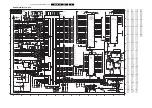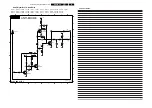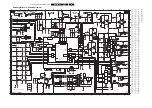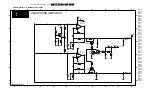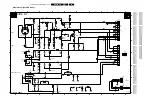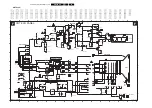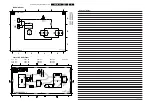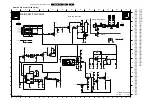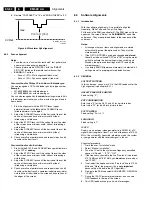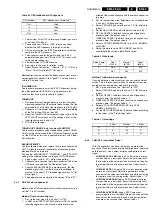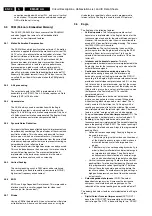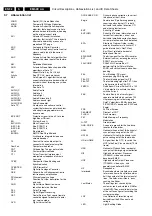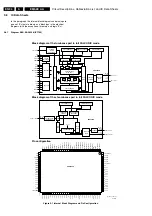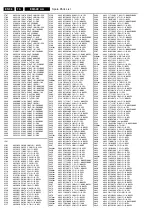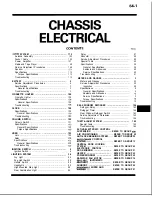
Alignments
EN 81
EM5.2E AA
8.
8.
Alignments
Index of this chapter:
8.1 General Alignment Conditions
8.2 Hardware Alignments
8.3 Software Alignments
8.4 Option Settings
8.1
General Alignment Conditions
8.1.1
Start Conditions
Perform all electrical adjustments under the following
conditions:
•
Power supply voltage: 230 V_ac / 50 Hz (
±
10 %).
•
Connect the set to the mains via an isolation transformer
with low internal resistance.
•
Allow the set to warm up for approximately 20 to 30
minutes.
•
Measure the voltages and waveforms in relation to chassis
ground (with the exception of the voltages on the primary
side of the power supply).
Caution:
never use the cooling fins/plates as ground.
•
Test probe: Ri > 10 Mohm, Ci < 20 pF.
•
Use an isolated trimmer/screwdriver to perform the
alignments.
Perform all electrical adjustments with the following start
settings (for all CRTs):
•
Set LIGHT SENSOR "off", by setting ACTIVE CONTROL
to "off" with the remote control.
•
Set CONTRAST to "75", BRIGHTNESS to "42" and
COLOUR to "54" (via PICTURE menu).
•
Set COLOUR ENHANCEMENT to "off" (via PICTURE
menu).
•
Set DIGITAL OPTIONS to "Pixel Plus" (via PICTURE
menu), unless otherwise stated (for sets without "Pixel
Plus" (= Eagle), set to "Natural Motion").
•
Set DYNAMIC CONTRAST to "off" (via PICTURE menu).
•
Set CATHODE DRIVE at "15" (via SAM - Alignments -
General - Drive - Cathode).
8.1.2
Adjustment Sequence
Use the following adjustment sequence:
1.
Set the correct TV-set "options" (after storing, restart the
set!).
2.
Rough adjustment of "Vg2".
3.
Rough adjustment of "Focus".
4.
Rough adjustment of "Geometry".
5.
Allow the set to warm up.
6.
Accurate adjustment of "Vg2" and "Focus".
7.
Accurate adjustment of "Geometry".
8.
Software alignments (cut-off, cathode drive, peak white,
white drive, etc).
8.2
Hardware Alignments
Note:
The Service Alignment Mode (SAM) is described in
chapter 5 of the Service Manual. Menu navigation is done with
the "CURSOR UP, DOWN, LEFT or RIGHT" keys of the remote
control (RC) transmitter.
Figure 8-1 Top-view LSP
8.2.1
Vg2 Adjustment
In the frame-blanking period of the R, G, and B signals applied
to the CRT, the "HOP" video processor inserts a measuring
pulse with different DC levels. Measure the black level pulse
during the vertical flyback at the RGB cathodes of the CRT.
1.
Go, via the MENU key, to the normal user menu, select
"PICTURE", and set "CONTRAST" and "BRIGHTNESS" to
"0"
.
2.
Activate the SAM.
3.
Connect the RF output of a pattern generator to the
antenna input. Test pattern is a "black" picture (blank
screen on CRT without any OSD info).
4.
Set the channel of the oscilloscope to 20 V/div and the time
base to 20 us/div. Use external triggering on the vertical
pulse
Caution
: use a trigger point at the "
cold"
side!.
5.
Ground the scope at the CRT panel ("
cold"
side) and
connect a 10:1 probe to one of the cathodes of the picture
tube socket (see diagram F).
6.
Measure the cut-off pulse during first full line after the
frame blanking. You will see two pulses, one being the cut-
off pulse and the other being the white drive pulse. Choose
the one with the lowest value; this is the cut-off pulse.
7.
Select the cathode with the highest V_dc value for the
alignment. Adjust the V_CUTOFF of this gun with the
SCREEN (lower) potentiometer on the LOT to the correct
DC-value, tolerance is +/- 3 V_dc (align the Vg2 potmeter
first till the flyback lines are just visible and then slowly turn
back until they are gone).
•
28 inch (16:9):
–
Philips (LPD): 160 V.
•
29 inch (4:3):
–
Philips (LPD): 160 V.
–
Samsung: 160 V.
•
32 inch (16:9):
–
Philips (LPD): 160 V.
–
Panasonic (MEC): 170 V.
CL 26532041_060.eps
110402
SSB
V.SHIFT
CINCH SCART
ER
3642
1502
5430
Focus 2
Focus 1
Screen
VG2
LOT
Warning
All alignments
are on hot-part
A
B
C

